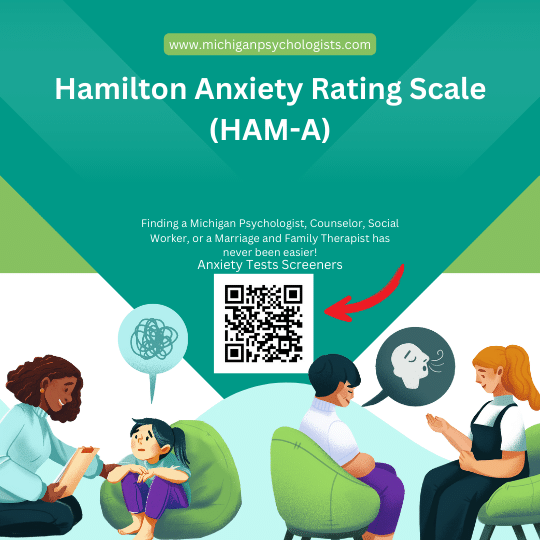Hamilton Anxiety Rating Scale (HAM-A)
Home » Psychological Tests » Anxiety Tests Screeners » Hamilton Anxiety Rating Scale (HAM-A)
Table of Contents
In the intricate landscape of mental health, anxiety disorders present as some of the most pervasive and challenging conditions. The need for precise assessment tools is paramount to diagnose and manage these disorders effectively. One such tool, the Hamilton Anxiety Rating Scale (HAM-A), has stood the test of time, providing clinicians with a robust framework to evaluate anxiety severity. This article delves into the HAM-A, elucidating its purpose, application, scoring, and accuracy, and addresses frequently asked questions to enhance your understanding of this pivotal instrument.
What is the Hamilton Anxiety Rating Scale (HAM-A)?
The Hamilton Anxiety Rating Scale (HAM-A) is one of the first scales developed to measure the severity of anxiety symptoms. Created by Dr. Max Hamilton in 1959, the HAM-A has been extensively used in both clinical and research settings. It is a clinician-administered assessment tool designed to quantify the level of anxiety and to track changes in symptom severity over time.
Purpose of the HAM-A
The primary purposes of the HAM-A are to:
- Assess the severity of anxiety symptoms in individuals.
- Provide a standardized method for evaluating the effectiveness of treatment interventions.
- Aid in the differential diagnosis of anxiety disorders.
How the Hamilton Anxiety Rating Scale (HAM-A) is Used
The HAM-A consists of 14 items, each defined by a series of symptoms. The clinician assesses each item based on the individual’s reported symptoms over the past week. The items are grouped into two categories: psychic anxiety (mental agitation and psychological distress) and somatic anxiety (physical complaints related to anxiety).
Steps to Administer the HAM-A:
- Clinical Interview: The clinician conducts a structured interview to assess the individual’s anxiety symptoms.
- Rating: Each of the 14 items is rated on a scale of 0 to 4, where 0 indicates absence of symptoms and 4 indicates severe symptoms.
- Scoring: The total score is calculated by summing the scores of all 14 items.
How the Hamilton Anxiety Rating Scale (HAM-A) is Scored
The HAM-A uses a simple scoring system to quantify anxiety severity. Each item is scored based on the clinician’s assessment during the interview.
Scoring Guidelines:
- 0-4: No symptoms
- 5-9: Mild symptoms
- 10-14: Moderate symptoms
- 15-19: Severe symptoms
- 20-56: Very severe symptoms
The total score ranges from 0 to 56, with higher scores indicating greater anxiety severity.
The Accuracy of the Hamilton Anxiety Rating Scale (HAM-A)
The HAM-A is widely recognized for its reliability and validity in assessing anxiety symptoms. It has been validated in numerous studies and is considered a gold standard for measuring anxiety in clinical trials and practice.
Key Points on Accuracy:
- Reliability: The HAM-A demonstrates high inter-rater reliability, meaning different clinicians are likely to produce similar scores when assessing the same individual.
- Validity: The scale has strong content validity, capturing a broad range of anxiety symptoms.
- Clinical Utility: The HAM-A is effective for both initial assessment and ongoing evaluation of treatment efficacy.
Frequently Asked Questions (FAQ)
1. What is the HAM-A used for?
The HAM-A is used to assess the severity of anxiety symptoms and to monitor changes in these symptoms over time.
2. How long does it take to complete the HAM-A?
The HAM-A typically takes about 15-20 minutes to complete, depending on the complexity of the individual’s symptoms.
3. Can the HAM-A diagnose anxiety disorders on its own?
No, the HAM-A is a tool for assessing symptom severity and should be used as part of a comprehensive diagnostic evaluation.
4. What is the scoring threshold for significant anxiety?
A total score of 17 or above is generally considered indicative of significant anxiety that may require intervention.
5. Are there any limitations to the HAM-A?
The HAM-A relies on the clinician’s subjective judgment and the individual’s self-reporting, which can introduce variability. It also focuses more on somatic symptoms, which may not capture the full spectrum of anxiety experiences.
6. Can the HAM-A be used for children and adolescents?
The HAM-A is primarily designed for adults, and other tools are more suitable for younger populations.
7. Is the HAM-A available in multiple languages?
Yes, the HAM-A has been translated and validated in several languages.
8. How often should the HAM-A be administered?
The HAM-A can be administered at regular intervals, such as weekly or monthly, to monitor changes in anxiety symptoms, especially during treatment.
9. What should be done if the HAM-A score indicates severe anxiety?
A high score on the HAM-A should prompt further evaluation and discussion with a healthcare professional to explore appropriate treatment options.
10. Can the HAM-A be used in conjunction with other assessment tools?
Yes, the HAM-A can be used alongside other assessment tools to provide a comprehensive evaluation of an individual’s mental health.
The Hamilton Anxiety Rating Scale (HAM-A) is a vital instrument in the assessment and management of anxiety disorders. Its structured approach and robust psychometric properties make it an invaluable tool for clinicians. By understanding how to use, score, and interpret the HAM-A, healthcare professionals can better identify and treat anxiety, ultimately improving patient outcomes.
